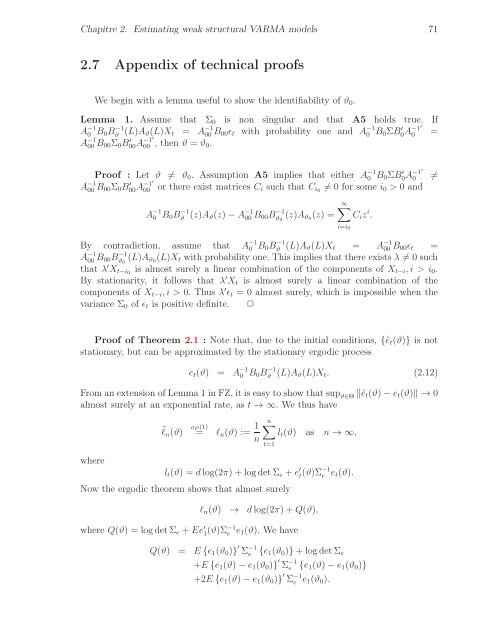THÈSE Estimation, validation et identification des modèles ARMA ...
THÈSE Estimation, validation et identification des modèles ARMA ...
THÈSE Estimation, validation et identification des modèles ARMA ...
Create successful ePaper yourself
Turn your PDF publications into a flip-book with our unique Google optimized e-Paper software.
Chapitre 2. Estimating weak structural V<strong>ARMA</strong> models 71<br />
2.7 Appendix of technical proofs<br />
We begin with a lemma useful to show the identifiability of ϑ0.<br />
Lemma 1. Assume that Σ0 is non singular and that A5 holds true. If<br />
A −1 −1<br />
0 B0Bϑ (L)Aϑ(L)Xt = A −1<br />
00B00ǫt with probability one and A −1<br />
0 B0ΣB ′ 0A−1′ 0 =<br />
A −1<br />
00B00Σ0B ′ 00A −1′<br />
00 , then ϑ = ϑ0.<br />
Proof : L<strong>et</strong> ϑ = ϑ0. Assumption A5 implies that either A −1<br />
0 B0ΣB ′ 0A−1′ 0 =<br />
A −1<br />
00B00Σ0B ′ 00A −1′<br />
00 or there exist matrices Ci such that Ci0 = 0 for some i0 > 0 and<br />
A −1<br />
0<br />
B0B −1<br />
ϑ<br />
−1 −1<br />
(z)Aϑ(z)−A 00B00Bϑ0 (z)Aϑ0(z) =<br />
By contradiction, assume that A −1<br />
0 B0B −1<br />
∞<br />
Ciz i .<br />
00B00ǫt =<br />
A −1 −1<br />
00B00Bϑ0 (L)Aϑ0(L)Xt with probability one. This implies that there exists λ = 0 such<br />
that λ ′ Xt−i0 is almost surely a linear combination of the components of Xt−i,i > i0.<br />
By stationarity, it follows that λ ′ Xt is almost surely a linear combination of the<br />
components of Xt−i,i > 0. Thus λ ′ ǫt = 0 almost surely, which is impossible when the<br />
variance Σ0 of ǫt is positive definite. ✷<br />
i=i0<br />
ϑ (L)Aϑ(L)Xt = A −1<br />
Proof of Theorem 2.1 : Note that, due to the initial conditions, {˜<strong>et</strong>(ϑ)} is not<br />
stationary, but can be approximated by the stationary ergodic process<br />
<strong>et</strong>(ϑ) = A −1 −1<br />
0 B0Bϑ (L)Aϑ(L)Xt. (2.12)<br />
From an extension of Lemma 1 in FZ, it is easy to show that sup ϑ∈Θ˜<strong>et</strong>(ϑ)−<strong>et</strong>(ϑ) → 0<br />
almost surely at an exponential rate, as t → ∞. We thus have<br />
where<br />
˜ℓn(ϑ)<br />
oP(1)<br />
= ℓn(ϑ) := 1<br />
n<br />
n<br />
lt(ϑ) as n → ∞,<br />
t=1<br />
lt(ϑ) = dlog(2π)+logd<strong>et</strong>Σe +e ′ t(ϑ)Σ −1<br />
e <strong>et</strong>(ϑ).<br />
Now the ergodic theorem shows that almost surely<br />
ℓn(ϑ) → dlog(2π)+Q(ϑ),<br />
where Q(ϑ) = logd<strong>et</strong>Σe +Ee ′ 1 (ϑ)Σ−1<br />
e e1(ϑ). We have<br />
Q(ϑ) = E{e1(ϑ0)} ′ Σ −1<br />
e {e1(ϑ0)}+logd<strong>et</strong>Σe<br />
+E{e1(ϑ)−e1(ϑ0)} ′ Σ −1<br />
e {e1(ϑ)−e1(ϑ0)}<br />
+2E{e1(ϑ)−e1(ϑ0)} ′ Σ −1<br />
e e1(ϑ0).
















